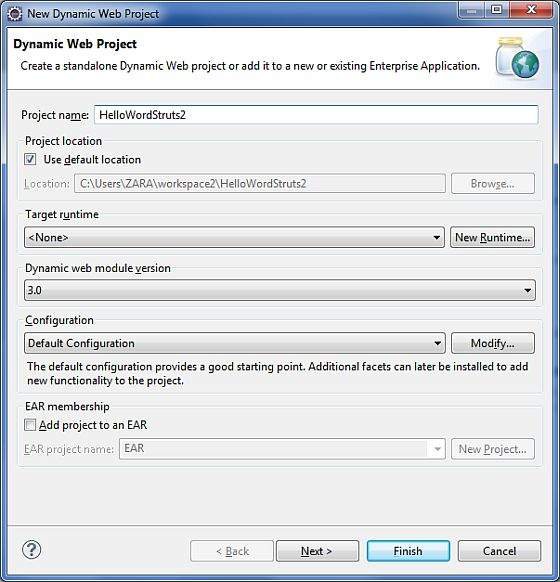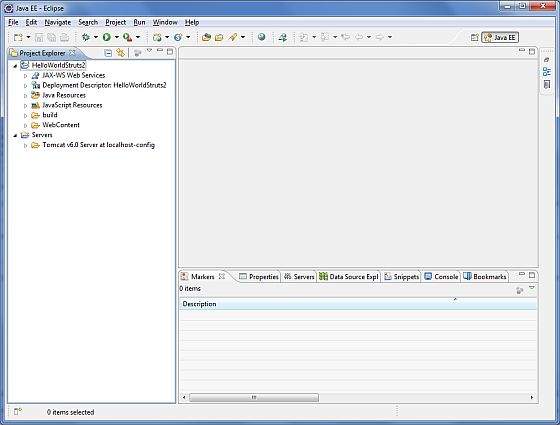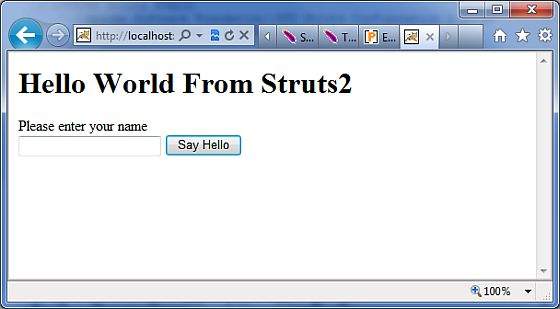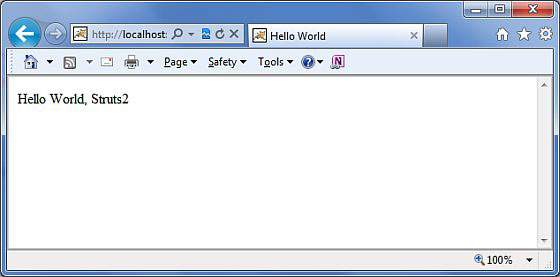原文地址:https://www.tutorialspoint.com/struts_2/
【注释】项目结构,次序估计有误

通过学习Struts2的架构,我们可以知道,在Struts2 web应用中,当你点击一个超链接、或者提交一个HTML表单的时候,用户的input将被传到Controller,之后Controller把input发送给叫做Action的Java class. 在Action被执行之后,Result会决定将哪个资源作为response的内容返回。这个资源通常是Jsp,当然也可以是一个PDF文件,又或者是个表格,或是Java applet窗口,等等。
假定你已经搭建好了开发所需要的环境。现在我们开始构建一个 Hello World struts2 project. 这个项目的目的是:创建一个web应用,可以输入用户的姓名,在用户提交后显示“Hello World” + “用户姓名”。下面4个组件是任何Struts2 project中都必须具备的:
| SN | Components & Description |
|---|---|
| 1 | Action
Create an action class which will contain complete business logic and control the interaction between the user, the model, and the view. |
| 2 | Interceptors
Create interceptors if required, or use existing interceptors. This is part of Controller. |
| 3 | View
Create a JSPs to interact with the user to take input and to present the final messages. |
| 4 | Configuration Files
Create configuration files to couple the Action, View and Controllers. These files are struts.xml, web.xml, struts.properties. |
我们打算使用Eclipse IDE,因此所有需要的组件都将被创建在一个动态Web工程下,所以让我们首先创建一个“Dynamic Web Project”。
创建一个 Dynamic Web Project:
启动你的Eclipse,然后依次打开 File > New > Dynamic Web Project 并且输入项目名“HelloWorldStruts2 ” ,其余选项不必改变(默认值就ok):

最后需要勾选 Generate Web.xml deployment descriptor 这个选项. 创建好的工程目录如下所示:

现在,把底下的这些文件从Struts2 lib文件夹复制到我们工程中的 WEB-INFlib 文件夹下:
-
commons-fileupload-x.y.z.jar
-
commons-io-x.y.z.jar
-
commons-lang-x.y.jar
-
commons-logging-x.y.z.jar
-
commons-logging-api-x.y.jar
-
freemarker-x.y.z.jar
-
javassist-.xy.z.GA
-
ognl-x.y.z.jar
-
struts2-core-x.y.z.jar
-
xwork-core.x.y.z.jar
创建Action类:
Action类是Struts2应用程序的核心,我们通过它实现大多数的业务逻辑。因此,我们首先在Java Resources > src 下创建一个HelloWorldAction.java,内容如下所示。
当用户点击一个URL时,由Action类响应用户操作。一个或者多个Action类的方法被执行,并且将返回一个String类型的result。基于这个result值,一个特定的JSP页面将被呈现。
package com.tutorialspoint.struts2; public class HelloWorldAction{ private String name; public String execute() throws Exception { return "success"; } public String getName() { return name; } public void setName(String name) { this.name = name; } }
这是一个非常简单的class,仅有一个叫做“name”的属性,这个属性具备标准的 getters 和setter 以及一个execute()的方法。
你也可以将你的动作名直接作为你的类名,或者如下面内容所示,使用 struts.xml 文件映射到其他名字上。
创建View
我们需要一个JSP来呈现最终信息。WebContent/HelloWorld.jsp :
<%@ page contentType="text/html; charset=UTF-8" %>
<%@ taglib prefix="s" uri="/struts-tags" %>
<html>
<head>
<title>Hello World</title>
</head>
<body>
Hello World, <s:property value="name"/>
</body>
</html>
taglib指令告诉Servlet容器(JSP只不过是Servlet的另一种写法!)这个页面将使用Struts2标签,并且这些标签将以s开头。
s:property 标签显示Action类“name”属性的值,这个值是使用HelloWorldAction类的 getName() 方法返回的。
创建主界面:
这个JSP用作初始的action URL. 用户可以通过点击该页面中的submit去请求HelloWord.jsp视图,其结果就是促使Struts2框架去调用action hello
WebContent/index.jsp
<%@ page language="java" contentType="text/html; charset=ISO-8859-1" pageEncoding="ISO-8859-1"%> <%@ taglib prefix="s" uri="/struts-tags"%> <!DOCTYPE html PUBLIC "-//W3C//DTD HTML 4.01 Transitional//EN" "http://www.w3.org/TR/html4/loose.dtd"> <html> <head> <title>Hello World</title> </head> <body> <h1>Hello World From Struts2</h1> <form action="hello"> <label for="name">Please enter your name</label><br/> <input type="text" name="name"/> <input type="submit" value="Say Hello"/> </form> </body> </html>
hello action将通过struts2.xml映射到的HelloWorldAction,最终调用HelloWorldAction中的execute()方法,并获取它的返回值,以此决定呈现哪个视图。
配置文件
我们需要一个“映射”把URL、HelloWorldAction class (Model),以及HelloWorld.jsp (the view)联系在一起。
这个“映射”告诉Struts2框架哪个class将响应用户的action(也就是URL),class的哪个方法将会被执行,方法返回的result所对应的视图是哪个。
WebContent/WEB-INF/classes/struts.xml
<?xml version="1.0" encoding="UTF-8"?> <!DOCTYPE struts PUBLIC "-//Apache Software Foundation//DTD Struts Configuration 2.0//EN" "http://struts.apache.org/dtds/struts-2.0.dtd"> <struts> <constant name="struts.devMode" value="true" /> <package name="helloworld" extends="struts-default"> <action name="hello" class="com.tutorialspoint.struts2.HelloWorldAction" method="execute"> <result name="success">/HelloWorld.jsp</result> </action> </package> </struts>
关于上面的配置文件,有几点要说明。
- 这里我们设定常数struts.devMode的值为真,因为我们是在开发环境下工作,需要查看一些有用的日志消息。
- 然后,我们定义一个名为helloworld的数据包。当你想要把你的Actions集合在一起时,创建一个数据包是非常有用的。
在我们的示例中,action被命名为“hello”,当URL /hello.action被调用的时候,HelloWorldAction.class 中的execute方法将被执行,如果execute方法的返回结果为success,那么就把HelloWorld.jsp呈现给用户。
下一个步骤是是创建一个web应用部署描述文件,它是把请求传给Struts2的一个接入点。
我们在web.xml中定义一个oforg.apache.struts2.dispatcher.FilterDispatcher类的接入点。
WEB-INF/classes
<?xml version="1.0" encoding="UTF-8"?> <web-app xmlns:xsi="http://www.w3.org/2001/XMLSchema-instance" xmlns="http://java.sun.com/xml/ns/javaee" xmlns:web="http://java.sun.com/xml/ns/javaee/web-app_2_5.xsd" xsi:schemaLocation="http://java.sun.com/xml/ns/javaee http://java.sun.com/xml/ns/javaee/web-app_3_0.xsd" id="WebApp_ID" version="3.0"> <display-name>Struts 2</display-name> <welcome-file-list> <welcome-file>index.jsp</welcome-file> </welcome-file-list> <filter> <filter-name>struts2</filter-name> <filter-class> org.apache.struts2.dispatcher.FilterDispatcher </filter-class> </filter> <filter-mapping> <filter-name>struts2</filter-name> <url-pattern>/*</url-pattern> </filter-mapping> </web-app>
<url-pattern>/*</url-pattern>:在所有的URL上运行Struts2 过滤器。
启用详细日志:
WEB-INF/classes/logging.properties
org.apache.catalina.core.ContainerBase.[Catalina].level = INFO org.apache.catalina.core.ContainerBase.[Catalina].handlers = java.util.logging.ConsoleHandler
默认由logging.properties指定一个ConsoleHandler将日志记录按指定路线发送给stdout和FileHandler。程序运行日志的级别阈值可以使用SEVERE,WARNING,INFO,CONFIG,FINE,FINER,FINEST或者ALL。
这样,我们就准备好使用Struts2运行我们的Hello World程序了。
执行应用程序
把程序打包成war然后部署到tomcat下,输入URL:http://localhost:8080/HelloWorldStruts2/index.jsp

输入Struts2,然后提交

定义索引页面的方法(通过http://localhost:8080/HelloWorldStruts2/index.action可以访问):
<?xml version="1.0" encoding="UTF-8"?> <!DOCTYPE struts PUBLIC "-//Apache Software Foundation//DTD Struts Configuration 2.0//EN" "http://struts.apache.org/dtds/struts-2.0.dtd"> <struts> <constant name="struts.devMode" value="true" /> <package name="helloworld" extends="struts-default"> <action name="index"> <result >/index.jsp</result> </action> <action name="hello" class="com.tutorialspoint.struts2.HelloWorldAction" method="execute"> <result name="success">/HelloWorld.jsp</result> </action> </package> </struts>